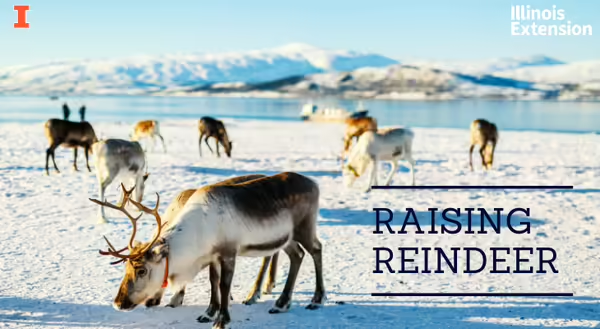
You know Dasher, and Dancer, and Prancer, and Vixon, and of course Rudolph from being a part of Santa’s trusty reindeer herd, but did you know that Santa isn’t the only one that is raising reindeer? It is thought that reindeer, Rangifer tarandus, were first domesticated around 5,000 to 7,000 years ago to attract wild deer so hunters could harvest them.
Wild and domesticated reindeer
Most wild reindeer are found in Norway, Finland, Siberia, and Greenland.
Domesticated reindeer provide meat, milk, tallow (fatty substance), and hides for blankets, clothing, and footwear. According to the University of Alaska, reindeer meat is high in protein (22%) and low in fat (3.5%). Today, many domesticated reindeer in the U.S. are used for Christmas events like parades and photo ops and can be found in most parts of the US including southern states Texas, Mississippi, and Tennessee.
Reindeer vs. caribou
Some people consider reindeer and caribou to be the same animal; however, the University of Alaska Fairbanks clarifies that these animals are the same species, but different subspecies.
- Caribou are more migratory animals that travel long distances for winter pasture and back home again for spring calving.
- Reindeer are much more sedentary animals with their movements staying within an established home area, but can you blame them; I would be sedentary too after flying around the world in one night. Reindeer gather together in a unit while caribou will scatter when being herded.
They also vary in their appearance with caribou being lean with long legs suitable for long migrations and reindeer being more robust with shorter legs and a flatter face.
All reindeer have antlers
Reindeer are the only deer species in which both the males and females grow antlers. Even the calves grow antlers during their first year! Each year these animals lose and regrow new antlers; with bulls and non-pregnant females losing their antlers during the winter, typically around Christmas time.
Pregnant females will not drop their antlers until they give birth in the spring; antlers are a sign of domination allowing a pregnant female to protect her food resources during scarce winter conditions which helps to protect her developing fetus. I'm not here to create any controversy, but the original artist should have probably done some research on reindeer before illustrating Santa’s herd as pregnant females!
Grazing
Much like deer, reindeer feed on grasses, leaves of shrubs and trees, mosses, and herbs. The average adult reindeer eats 9 to 18 lbs of vegetation each day. During the winter months, reindeer feed largely on lichen, so rather than leaving the reindeer carrots this Christmas, maybe you could search for some lichen to leave out for them ?. They are also subject to common deer diseases such as Brucellosis, Chronic Wasting Disease, and West Nile Virus.
The University of Alaska currently has an extensive research program focused on reindeer management and nutrition, as well as, their overall health.
Good Growing Tip: If you are interested in more information about raising reindeer, the Reindeer Owners and Breeders Association in the U.S. has beneficial information, and you can find a local farm to visit too!
The Good Growing team wishes you and your loved ones a healthy and happy holiday season, and we look forward to growing with you in 2021!